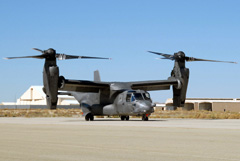
|
CV-22 Team Concludes
Developmental Testing at Edwards
|
|
|
10/1/2007 - EDWARDS AIR FORCE BASE, CA. -- The CV-22 Integrated Test Team marked the conclusion of developmental flight testing of the CV-22 Osprey during a farewell event at the 418th Flight Test Squadron here, Sept. 26. The CV-22 program is now graduating from developmental testing to the operational test phase, which will be held at Hurlburt Field, Fla., in October. In the operational test phase, the users will evaluate the aircraft and systems in a mission-representative environment over the next six to nine months. The CV-22 ITT was established in 2000 with members of Bell Helicopter, Boeing, Naval Air Systems Command, United States Marine Corps, Air Force Materiel Command, Air Force Special Operations Command and the Air Force Operational Test and Evaluation Center. The test team started in 2002 with two of the tilt-rotor aircraft with the task of developing the CV-22's unique systems, said Steve Sisterman, CV-22 ITT director. "Edwards was selected as the test site for the CV-22 because of the unique surrounding environment, terrain features and the test ranges and facilities in the local area," he said. After the period of modifications and ground testing at the Benefield Anechoic Facility, flight testing began in September 2002, Mr. Sisterman said. "We then added a third aircraft in February of 2005," he said. "Together, these three aircraft have flown about 2,000 flight hours in support of the CV-22 test program. In those 2,000 hours, we have met all of our test objectives and goals." One of the test team's primary focuses was evaluating design changes made to the aircraft, said Maj. Steve Grace, CV-22 ITT government flight test director. "The Marines had some difficulties with their aircraft a number of years ago," he said. "As a result, design changes were made to the hydraulic system throughout the aircraft. Also, there were changes to the warnings and cautions transmitted to the pilots in order to provide them with a better account for dynamic changes in the flight path." The Marines tested many of the early design changes on their aircraft at Patuxent River Naval Air Station, Md., which were implemented on the CV-22's here, Major Grace said. "Our focus is not only on safe flight, but on the safe operation of the systems, which make up the special operations mission," he said. One of the testers' concerns was whether the terrain-following radar would give the crew confidence in the terrain profiles that they are flying towards, Major Grace said. "Our results have shown that the crews do have that confidence," he said. "The system works very well and provides a substantial capability to the pilots that will be very valuable as they go into missions." Major Grace said design changes to the aircraft have made the CV-22 a substantially different and improved aircraft than it was in 2000. "We also did work with the basic flying qualities of the aircraft," he said. "There were some issues at low speed that the pilots wanted tweaked. We coordinated with the Marines and made changes to the aircraft's control system to make the CV-22 and MV-22 better handling aircraft." The CV-22 and the MV-22 are different variations of the same basic aircraft, Major Grace said. The Marines will take delivery of 350 MV-22s and the Air Force will receive 50 CV-22's. The CV-22 includes the same components of the Marine version as well as additional features specific to the Air Force mission, he said. "The first difference is the terrain-following radar, which is a cylindrical feature projecting from the nose," Major Grace said. "That allows the special operations pilots to ingress and egress in hostile areas at a substantially lower altitude." The radar looks out in front of the aircraft and makes sure there is adequate clearance from hills and mountains while allowing the crews to stay close to the ground, he said. The aircraft was tested as close as 200 feet over mountainous terrain. Another significant difference between the CV-22 and MV-22 is the electronic warfare systems, Major Grace said. "The CV-22 has a self protection radio jammer and infrared jammer that allows us to have additional survivability against surface to air threats," he said. "Finally, the aircraft has some additional avionics capability such as two radios for better communications with the ground and a dual digital map system." Now that developmental testing is complete, the CV-22 test site at Edwards is being closed down. The CV-22 is scheduled to enter operational service with AFSOC in 2009. The CV-22 represents an important technology jump, said Gary Matlin, CV-22 ITT deputy director. "We are very much enamored with what we have done with the CV-22 here," Mr. Matlin said. "We appreciate the cooperation we received from everyone." Source: USAF Edwards AFB Press Release by Senior Airman Jason Hernandez |
|
|
All original content Copyright © 2006 - 2008 The North Spin
